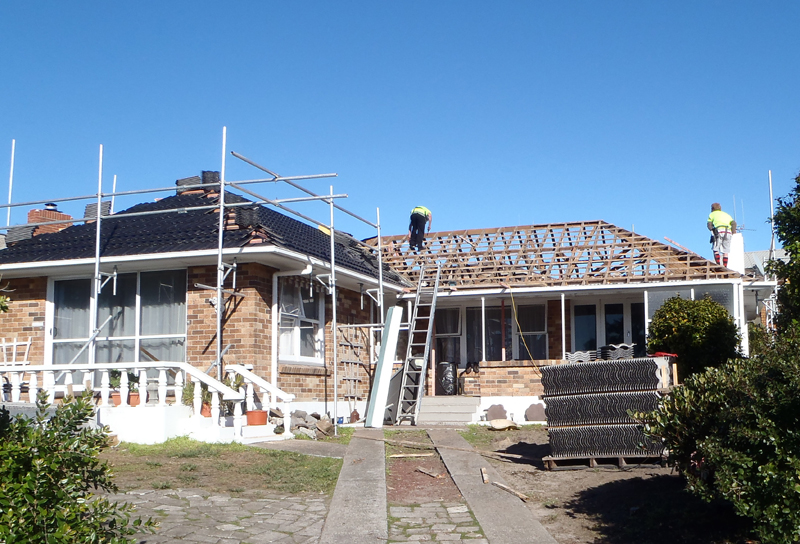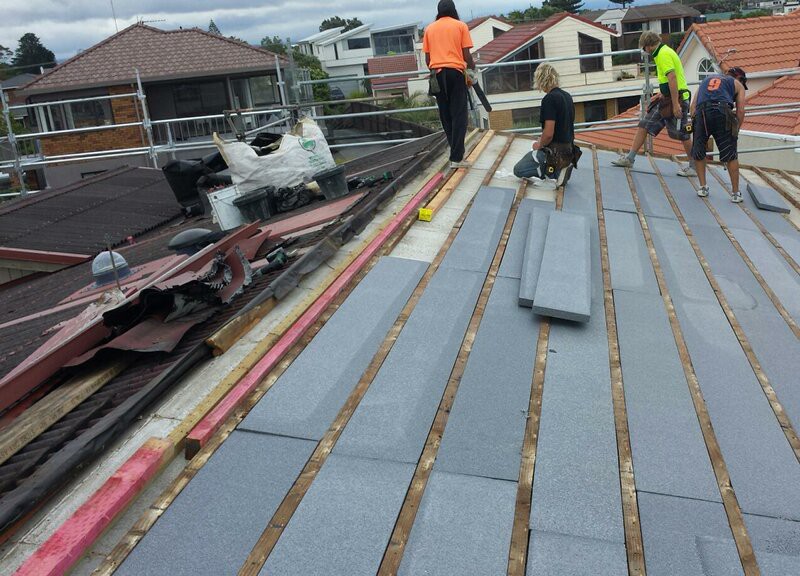
Posted: 08 May 2015

A new roof will lift the value of your property and will not only look great but will also provide decades of protection for your biggest and most valuable asset. By law all roofs in New Zealand have to have a minimum durability of 15 years. Many roofs will last two or three times as long because the house and roof were properly designed, professionally installed and well looked after. But all roofs have a finite lifespan and will eventually need to be replaced. Here are some explanations on the whole process of Re-roofing.
1) You want a change (redesigning)
2) Your roof has failed: loss of its colour, corrosion, rust, mould and even leaks. The reasons could be old age, wrong fit for its purpose (wrong material for the environment), poor maintenance or structural reasons (poor design/installation).
When you re-roof, it’s very important that you take a long term view in regard to the cost. Costs can be broken down into up-front cost (material and installation) and lifecycle cost. Cheap up-front costs aren’t necessarily going to save you money in the long term. Installing a roof using cheap materials and/or less than reputable tradesmen may mean you’ll have to replace the roof in only a few years, possibly at your cost, because it didn’t meet regulations in the first place and the installers are no longer in business.
The process begins by asking lots of questions such as:
Choosing the contractor
1. How do I find a professional roofing contractor? Referral is the best way, ask around, contact your local roofing material distributor, the NZ roofing association.
2. How many estimates should I get before selecting a roofing contractor? The rule seems to be 3, but keep in mind that a low price can signal a lot of discrepancies and shortcomings in the reliability of the contractor.
3. How long is it reasonable to expect to wait after I select a contractor for work to begin? 4 to 6 weeks, weather permitting. This can vary depending on the time of year and the contractor’s backlog, however the contractor has a responsibility to be straightforward about his availability right from the start
4. What is the typical duration of a reroofing job? Depending on the size/complexity of the roof: a small, uncomplicated roof job can be finished in 2 days; a large, complex project can take around a week. Once started, a job should not be interrupted for any reason other than weather. However, if a problem arises in the Re-roofing process, it might be necessary to halt the work to negotiate a change in the contract. You should always be advised of any changes which affect the contract agreement.
5. How does extreme weather affect reroofing projects? Bad weather can interrupt or postpone roofing projects. Safety of the worker is the first consideration , the second is keeping the house dry.
6. Should I expect to pay a deposit when I sign an agreement? Yes, to secure the materials but you should never pay for the total job up front.
Choosing the product: Your decision can be affected by the weather, the house orientation, the neighbourhood and your house’s architectural style. To help you choosing the right product, discuss the following points with your contractor:
7. What sort of climatic conditions will the roof be exposed to?
8. Which way’s north and which way does the prevailing wind come from?
9. What is roof slope? Does the slope of the roof limit the choice of product that can be used?
10. What sort of profile should my roof have?
11. What sort of pre-painted roofing system do I want or need?
12. What colour can or should I choose?
13. Do I need to obtain a permit to install a new roof on my home?
14. What type of warranty should I look for? Aren’t they all the same?
See our other articles on choosing a new roof and choosing a roof colour.
The existing roof: If you are re-roofing because the existing roof failed, talk to your builder/roofer/ architect, to work out what caused it. It’s important to get rid of any existing problem(s) before you begin the re-roofing process, otherwise the same things will happen all over again, in a few years’ time, and you will have wasted your money. Again, you can ask your contractor the next questions.
15. Is it always necessary to tear off existing shingles/tiles before reroofing? If they are torn off, who is responsible for their disposal?
16. How can I determine if the roof is properly ventilated
17. What function does underlayment serve?
18. Does the roof framing structure – rafters, beams, purlins etc – need replacing or repair?
19. How good are spoutings, down pipes and other rainwater systems? Do they need replacing too?
20. How’s the insulation in the ceiling space? (It’s a lot easier/quicker to install insulation when the roof is off).
It can be described in 10 steps:
1 Set up scaffolding/edge protection
2 Remove old tiles/roofing iron
3 Inspect roof structure for defects
4 Prepare roof surface (Drip edge, underlay) - Install insulation when required
5 Install new battens or purlins if necessary
6 Load up roofing materials
7 Lay roofing products
8 Lay ridge tiles/install flashings
9 Pointing, nailing/Rivets and sealants
10 Finish – Site clean-up – Final inspection
If you have any questions, we would be happy to hear from you. Call us on 07 574 7058 or email us.
More info:
Watch a Video on Youtube: Re-roofing Monier tiles
Before/after project pics on Pinterest.
